Chemistry, Department of: Faculty Series

Patrick Dussault Publications
Document Type
Article
Date of this Version
2015
Citation
J Nutr 2015;145:1402–7.
Abstract
Background: Elevated concentrations of LDL cholesterol are associated with the development of atherosclerosis and therefore are considered an important target for intervention to prevent cardiovascular diseases. The inhibition of cholesterol absorption in the small intestine is an attractive approach to lowering plasma cholesterol, one that is addressed by drug therapy as well as dietary supplementation with plant sterols and plant sterol esters (PSEs).
Objective: This study was conducted to test the hypothesis that the cholesterol-lowering effects of PSE require hydrolysis to free sterols (FSs).
Methods: Male Syrian hamsters were fed atherogenic diets (AIN-93M purified diet containing 0.12% cholesterol and 8% coconut oil) to which one of the following was added: no PSEs or ethers (control), 5% sterol stearate esters, 5% sterol palmitate esters (PEs), 5% sterol oleate esters (OEs), 5% sterol stearate ethers (STs; to mimic nonhydrolyzable PSE), or 3% FSs plus 2% sunflower oil. The treatments effectively created a spectrum of PSE hydrolysis across which cholesterol metabolism could be compared. Metabolic measurements included cholesterol absorption, plasma and liver lipid concentration, and fecal neutral sterol and bile acid excretion.
Results: The STs and the PEs and SEs were poorly hydrolyzed (1.69–4.12%). In contrast,OEs were 88.3% hydrolyzed. The percent hydrolysis was negatively correlated with cholesterol absorption (r=20.85; P < 0.0001) and positively correlated with fecal cholesterol excretion (r = 0.92; P < 0.0001), suggesting that PSE hydrolysis plays a central role in the cholesterol-lowering properties of PSE.
Conclusions: Our data on hamsters suggest that PSE hydrolysis and the presence of FSs is necessary to induce an optimum cholesterol-lowering effect and that poorly hydrolyzed PSEs may lower cholesterol through an alternative mechanism than that of competition with cholesterol for micelle incorporation.


Comments
Copyright 2015 American Society for Nutrition.